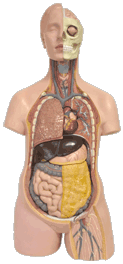At WiseGEEK, we're committed to delivering accurate, trustworthy information. Our expert-authored content is rigorously fact-checked and sourced from credible authorities. Discover how we uphold the highest standards in providing you with reliable knowledge.
What Is an Osteoclast?
Osteoclasts are large cells with more than one nucleus. Generally, they will contain 5 to 20 nuclei, but may have as many as 200. They are found in indendations in bone, that are slightly larger than the osteoclast itself. Researchers believe that osteoclasts actively create these holes, known as "Howship's lacunae."
On the side of the osteoclast that is next to the bone, there is a an array of microvilli that enter the bone. This border constitutes the active surface of the cell, where it can break down the bone. Osteoclasts produce several enzymes that allow them to resorb bone, but the primary one is acid phosphatase.

The enzymes produced by osteoclasts are capable of removing the inorganic calcium and phosphorus from the bone tissue. They can also break down organic material, such as collagen, that constitutes the bone itself. Initially, the bone is broken apart with the minerals still inside of the tissue.
When an osteoclast is digesting bone tissue, it seals itself above a notch in the bone. This creates an area known as a resorptive pit beneath the cell. Certain enzymes, including cathepsin K, are released into the the pit, dissolving the bone into pieces. The osteoclast takes up pieces of bone and dissolves them.
During this process, the minerals calcium and phosphorus are brought inside the osteoclast in special sealed compartments called vesicles. The vesicles travel through the cell and are released into the bloodstream. This process can be used to increase mineral levels in the body, since calcium and phosphorus are used for many processes. Osteoclasts will not resorb bone that does not contain minerals, however, since this bone is generally still in a state of development.
Osteoblasts and osteoclasts are created from different cellular processes. Certain proteins, like macrophage colony stimulating factor (MCSF), must be present in order for cells to differentiate into osteoclasts. Osteoblasts create these proteins, however, so their presence is necessary for osteoclasts to develop. Deficiencies in genes coding for MCSF and other proteins can lead to a lack of osteoclasts. It can also lead to the development of osteopetrosis, a rare condition where the bones get harder.
AS FEATURED ON:
AS FEATURED ON:










Discuss this Article
Post your comments